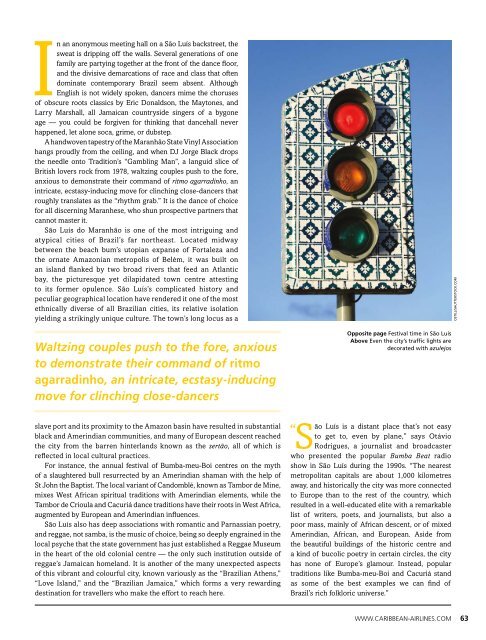You also want an ePaper? Increase the reach of your titles
YUMPU automatically turns print PDFs into web optimized ePapers that Google loves.
In an anonymous meeting hall on a São Luís backstreet, the<br />
sweat is dripping off the walls. Several generations of one<br />
family are partying together at the front of the dance floor,<br />
and the divisive demarcations of race and class that often<br />
dominate contemporary Brazil seem absent. Although<br />
English is not widely spoken, dancers mime the choruses<br />
of obscure roots classics by Eric Donaldson, the Maytones, and<br />
Larry Marshall, all Jamaican countryside singers of a bygone<br />
age <strong>—</strong> you could be forgiven for thinking that dancehall never<br />
happened, let alone soca, grime, or dubstep.<br />
A handwoven tapestry of the Maranhão State Vinyl Association<br />
hangs proudly from the ceiling, and when DJ Jorge Black drops<br />
the needle onto Tradition’s “Gambling Man”, a languid slice of<br />
British lovers rock from 1978, waltzing couples push to the fore,<br />
anxious to demonstrate their command of ritmo agarradinho, an<br />
intricate, ecstasy-inducing move for clinching close-dancers that<br />
roughly translates as the “rhythm grab.” It is the dance of choice<br />
for all discerning Maranhese, who shun prospective partners that<br />
cannot master it.<br />
São Luís do Maranhão is one of the most intriguing and<br />
atypical cities of Brazil’s far northeast. Located midway<br />
between the beach bum’s utopian expanse of Fortaleza and<br />
the ornate Amazonian metropolis of Belém, it was built on<br />
an island flanked by two broad rivers that feed an Atlantic<br />
bay, the picturesque yet dilapidated town centre attesting<br />
to its former opulence. São Luís’s complicated history and<br />
peculiar geographical location have rendered it one of the most<br />
ethnically diverse of all Brazilian cities, its relative isolation<br />
yielding a strikingly unique culture. The town’s long locus as a<br />
Waltzing couples push to the fore, anxious<br />
to demonstrate their command of ritmo<br />
agarradinho, an intricate, ecstasy-inducing<br />
move for clinching close-dancers<br />
Opposite page Festival time in São Luís<br />
Above Even the city’s traffic lights are<br />
decorated with azulejos<br />
ostill/shutterstock.com<br />
slave port and its proximity to the Amazon basin have resulted in substantial<br />
black and Amerindian communities, and many of European descent reached<br />
the city from the barren hinterlands known as the sertão, all of which is<br />
reflected in local cultural practices.<br />
For instance, the annual festival of Bumba-meu-Boi centres on the myth<br />
of a slaughtered bull resurrected by an Amerindian shaman with the help of<br />
St John the Baptist. The local variant of Candomblé, known as Tambor de Mine,<br />
mixes West African spiritual traditions with Amerindian elements, while the<br />
Tambor de Crioula and Cacuriá dance traditions have their roots in West Africa,<br />
augmented by European and Amerindian influences.<br />
São Luís also has deep associations with romantic and Parnassian poetry,<br />
and reggae, not samba, is the music of choice, being so deeply engrained in the<br />
local psyche that the state government has just established a Reggae Museum<br />
in the heart of the old colonial centre <strong>—</strong> the only such institution outside of<br />
reggae’s Jamaican homeland. It is another of the many unexpected aspects<br />
of this vibrant and colourful city, known variously as the “Brazilian Athens,”<br />
“Love Island,” and the “Brazilian Jamaica,” which forms a very rewarding<br />
destination for travellers who make the effort to reach here.<br />
“<br />
São Luís is a distant place that’s not easy<br />
to get to, even by plane,” says Otávio<br />
Rodrigues, a journalist and broadcaster<br />
who presented the popular Bumba <strong>Beat</strong> radio<br />
show in São Luís during the 1990s. “The nearest<br />
metropolitan capitals are about 1,000 kilometres<br />
away, and historically the city was more connected<br />
to Europe than to the rest of the country, which<br />
resulted in a well-educated elite with a remarkable<br />
list of writers, poets, and journalists, but also a<br />
poor mass, mainly of African descent, or of mixed<br />
Amerindian, African, and European. Aside from<br />
the beautiful buildings of the historic centre and<br />
a kind of bucolic poetry in certain circles, the city<br />
has none of Europe’s glamour. Instead, popular<br />
traditions like Bumba-meu-Boi and Cacuriá stand<br />
as some of the best examples we can find of<br />
Brazil’s rich folkloric universe.”<br />
WWW.CARIBBEAN-AIRLINES.COM 63

















